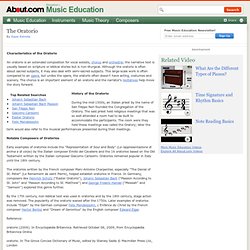

MUSICA DI NATALE SINFONIA BACH (MUSICA CLASSICA) Oratorio The World God Only Knows - God only knows (Full Version) w/ Lyrics. Handel - Glory to God (from the Oratorio Joshua) Händel's Oratorios. : Featured Composer at Boosey.com Music Shop. Handel was the cosmopolitan composer of his age, and one of music’s greatest melodists.

He is most famed as a composer of oratorios such as the evergreen Messiah, and works for ceremonial occasions such as the Water Music and the Music for the Royal Fireworks. He is also increasingly recognised as one of history’s leading opera composers, investing the formal framework of the time with vivid characterisation and larger-than-life emotions. He wrote for the leading vocalists of the day, exploiting their virtuosity in operas such as Julius Caesar, Tamerlano and Rodelinda, while also capable of a touching simplicity in arias including the famous Largo from Xerxes.
Handel, like Bach, was born in 1685 in Germany. He trained as a keyboard player and set out to seek his fortune in Hamburg, working first as a violinist and developing his talents as a composer. The Oratorio - History and Composers of Oratorios. Characteristics of the Oratorio An oratorio is an extended composition for vocal soloists, chorus and orchestra; the narrative text is usually based on scripture or biblical stories but is non-liturgical.

Although the oratorio is often about sacred subjects, it may also deal with semi-sacred subjects. This large-scale work is often compared to an opera, but unlike the opera, the oratorio often doesn't have acting, costumes and scenery. The chorus is an important element of an oratorio and the narrator's recitatives help move the story forward. History of the Oratorio During the mid-1500s, an Italian priest by the name of San Filippo Neri founded the Congregation of the Oratory. Notable Composers of Oratorios Early examples of oratorios include the "Representation of Soul and Body" (La rappresentazione di anima e di corpo) by the Italian composer Emilio del Cavaliere and the 16 oratorios based on the Old Testament written by the Italian composer Giacomo Carissimi. Reference: oratorio. Oratorio.
History[edit] 1600, origins of the oratorio[edit] Although medieval plays such as the Ludus Danielis, and Renaissance dialogue motets such as those of the Oltremontani had characteristics of an oratorio, the first oratorio is usually seen as Emilio de Cavalieri's Rappresentatione di Anima, et di Corpo.

Monteverdi composed Il Combattimento di Tancredi e Clorinda which can be considered as the first secular oratorio. 1650–1700[edit] By the mid-17th century, two types had developed: Lasting about 30–60 minutes, oratorio volgares were performed in two sections, separated by a sermon; their music resembles that of contemporary operas and chamber cantatas. oratorio latino (in Latin) – first developed at the Oratorio del Santissimo Crocifisso, related to the church of San Marcello al Corso in Rome. The late baroque oratorio[edit] In the late baroque oratorios increasingly became "sacred opera".